- Army
- Conflicts in the world
- Israel - Iran conflict 2025
- Pakistan - India Conflict 2025
- Russia Ukraine War 2022
- Libya conflict day by day
- HAMAS - Israel War 2023
- Operation Serval in Mali French Army
- Sangaris operation Central African Republic
- Sangaris opération militaire République Centreafrique
- Ukraine - Russia conflict
- Syria conflict news
- Defence & Security Industry Technology
- Armies in the world
- Analysis Defense and Security Industry
- Conflicts in the world
- Navy
- Air
Analysis by Army Recognition Group of military air power deployed in Syria by Russian Air Force 10410154
|
|
|||
|
The conflict in Syria
|
|||
|
|
|||
| Analysis by Army Recognition Group of military air power deployed in Syria by Russian Air Force. | |||
|
The first analysis of Army Recognition Group about Air power deployed by Russian air Force in Syria. All the fighter are located in the Latakia’s airfield in Syria. A total of thirty-four combat aircraft are used by Russian air force to carry out airstrikes against Islamic State fighters.
|
|||
|
|
|||
 Technicians at Syria's Hmeimim airport where Russian aircraft are deployed. © Dmitriy Vinogradov / RIA Novosti Technicians at Syria's Hmeimim airport where Russian aircraft are deployed. © Dmitriy Vinogradov / RIA Novosti |
|||
|
|
|||
|
The fighter deployed by Russian air Force in Syria are six Su-34 (NATO code Fullback) bomber aircraft, Su-30 (NATO code Flanker-C) twin-engine fighter aircraft, twelve Su-24M (NATO code Fencer) bomber aircraft and twelve Su-25 (NATO code Frogfoot) air-support combat aircraft.
In addition to thirty-four combat aircraft, up to twenty Mi-17s and Mi-24/35s, two Il-20s and at least three types of unmanned aerial vehicles are now deployed in Syria. The Su-24 front-line attack aircraft/interdictor is manufactured by the Sukhoi Design Bureau Joint Stock Company, based in Moscow, and the Novosibirsk Aircraft Production Association, Novosibirsk, Russia. The Su-24M entered service in 1983 and is a development of the Su-24, known by the NATO codename "Fencer". The first production Su-24 went airborne on December 31st, 1971. The Su-24 would not be formally accepted into service until February 6th, 1975. |
|||
| Su-24 Technical data sheet | |||
|
|
|||
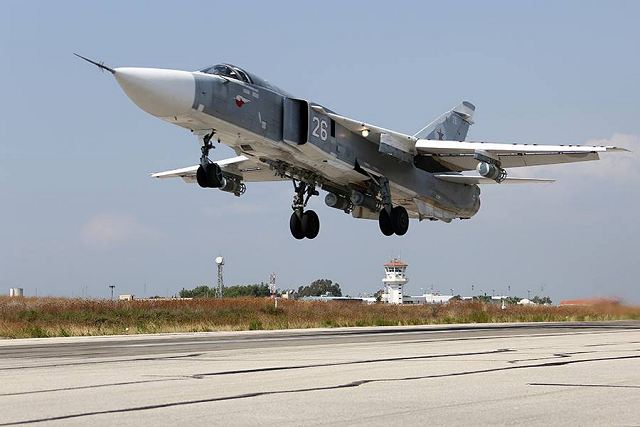 Su-24 at airfield at Syria's Hmeimim airfield Su-24 at airfield at Syria's Hmeimim airfield |
|||
|
|
|||
|
The Sukhoi Su-25 (NATO reporting name: "Frogfoot") is a single-seat, twin-engine jet aircraft developed in the Soviet Union by the Sukhoi Design Bureau. Sukhoi Design Bureau started work to produce the Su-25 attack aircraft in 1968. The new plane was meant for support of troops from directly over the battlefield and was designed to be an extremely easy-to-use and maintain subsonic jet aircraft with superior manoeuvrability and damage control.
|
|||
| Su-25 Technical data sheet | |||
|
|
|||
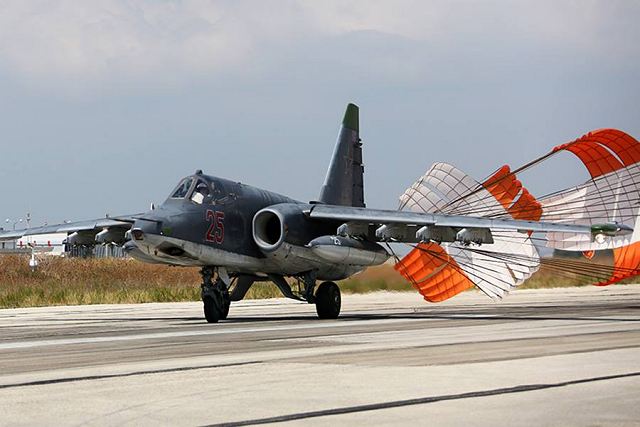 Su-25 at airfield at Syria's Hmeimim airfield Su-25 at airfield at Syria's Hmeimim airfield |
|||
|
|
|||
|
The Sukhoi Su-30 SU-30M (NATO code Flanker-C) is a twin-engine fighter aircraft developed by Russia's Sukhoi Aviation Corporation. It is a multirole fighter for all-weather, air-to-air and air-to-surface deep interdiction missions
|
|||
| Su-30SM technical data sheet | |||
|
|
|||
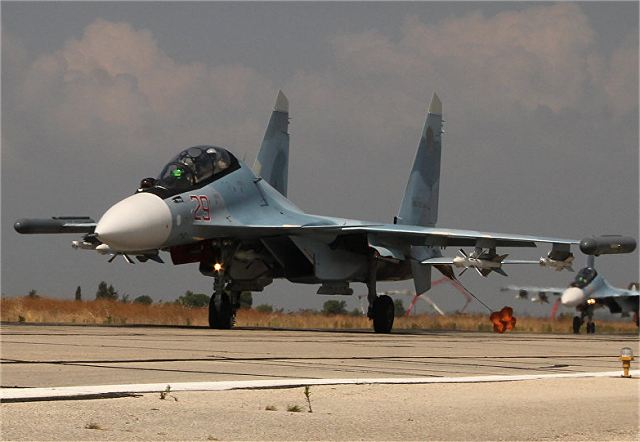 Russian air Force Su-30 fighter aircraft Russian air Force Su-30 fighter aircraft |
|||
|
|
|||
|
The Sukhoi Su-34 (NATO reporting name: Fullback) is a Russian twin-engine, twin-seat strike fighter manufactured by Sukhoi Company. The Su-34 is based on the Su-27 Flanker and is intended to replace the Sukhoi Su-24. The Su-34 multirole aircraft combines the properties of an air superiority fighter, an air-defense suppression aircraft, and a strike aircraft. It can equally defeat diverse aerial, ground, and sea targets.
|
|||
| Su-34 technical data sheet | |||
|
|
|||
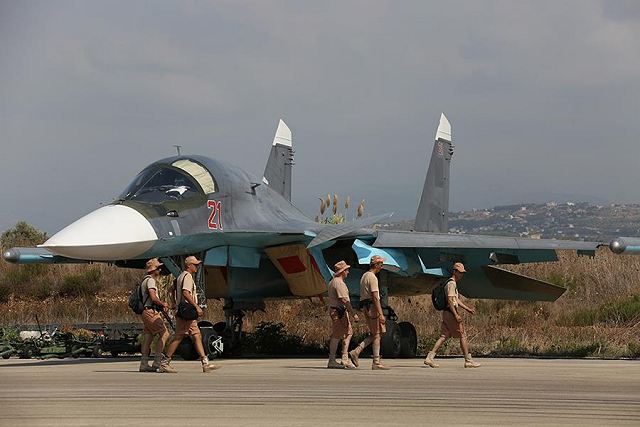 Su-34 at airfield at Syria's Hmeimim airfield Su-34 at airfield at Syria's Hmeimim airfield |
|||
|
|
|||
|
The Mi-17 is a Russian-made helicopter currently in production at two factories in Kazan and Ulan-Ude. Mi-17 medium twin-turbine multipurpose helicopter is a deep modernization of well-reputed Mi-8 rotorcraft. Its versatility and high performance characteristics made it the most popular helicopter in the world.
|
|||
|
|
|||
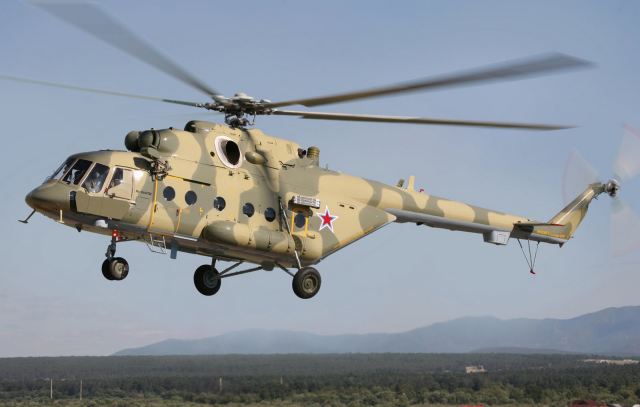 Russian air Force Mi-17 transport helicopter Russian air Force Mi-17 transport helicopter |
|||
|
|
|||
|
The Mi-24V/Mi-35 "Hind-E" (export variant) (NATO reporting name: Hind) is a multirole combat helicopter with low-capacity troop transport manufactured by the Russian company Rostverol. It is the result of more than 45 years of research and development, since the first flight of the prototype in 1969. The Mi-24V/Mi-35 entered production in 1976, and nearly 1.500 had been built in Arsenyev and Rostov by 1986.
|
|||
| Mi-34V/Mi-35 technical data sheet | |||
|
|
|||
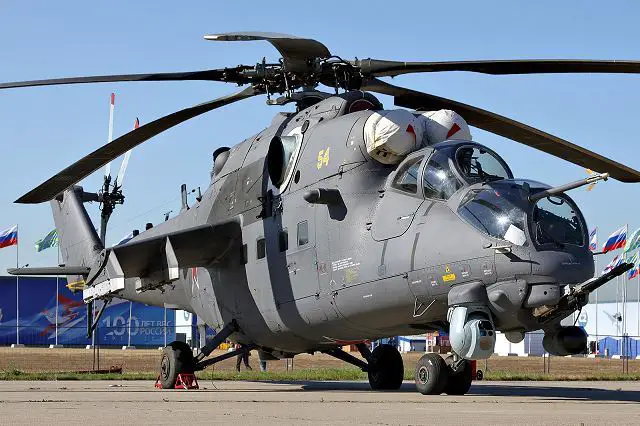 Russian air Force Mi-35 attack helicopter Russian air Force Mi-35 attack helicopter |
|||
|
|
|||
|
KAB-500Kr, KAB-500-OD, KAB-1500Kr are guided and corrected air bombs
The KAB-500Kr corrected air bomb is designed to engage stationary ground/surface small-sized hardened targets, such as reinforced concrete shelters, runways, railway and highway bridges, military industrial installations, warships, and transport vessels. The KAB-500-OD corrected air bomb is designed to engage ground targets, such as fire emplacemnts, and manpower hidden in mountainous terrains. The KAB-1500Kr corrected air bomb is designed to engage various stationary ground/surface small-sized hardened targets, such as reinforced concrete shelters, military industrial installations, depots, and seaport terminals. The KAB-500Kr, KAB-500-OD, KAB-1500Kr corrected air bombs are fitted with TV/terrain-matching homing heads and various types of warheads. TV homers with target data processing correlation algorithm can "remember" target location and correct bomb's flight trajectory until the impact on the target, thus realizing the "fire and forget" principle. Such homing heads can help defeat low-contrast and masked targets provided that terrain reference points and target coordinates related to them are available. The KAB-500Kr, KAB-500-OD, KAB-1500Kr corrected air bombs make part of weapon systems of such front-line aircraft types as Su-27, Su-30, Su-34, Su24M, MIG-29 and others. The delivery set can be completed with the KAB-500Kr-U training bomb used for pilots' mastering combat employment skills for KAB-500Kr, KAB-500-OD and KAB-1500Kr corrected air bombs. The KAB-500Kr-U training bomb parameters are as follows: weight - 85kg, length 1,83m, diameter - 0,35m. |
|||
|
|
|||
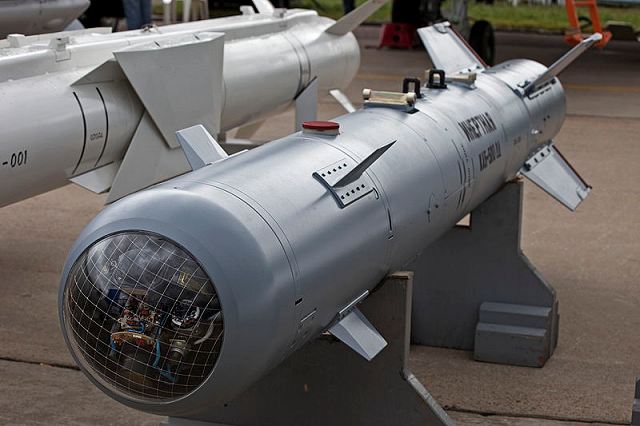 The smart bomb KAB-500OD at MAKS 2009. The smart bomb KAB-500OD at MAKS 2009. |
|||
|
|
|||
|
The BetAB 500 Concrete Piercing bomb is a thick cased High Explosive blast and fragmentation bomb designed to penetrate re-enforced targets such as bunkers then explode to produce destructive effect through blast overpressure and the fragmentation of the casing.
|
|||
|
|
|||
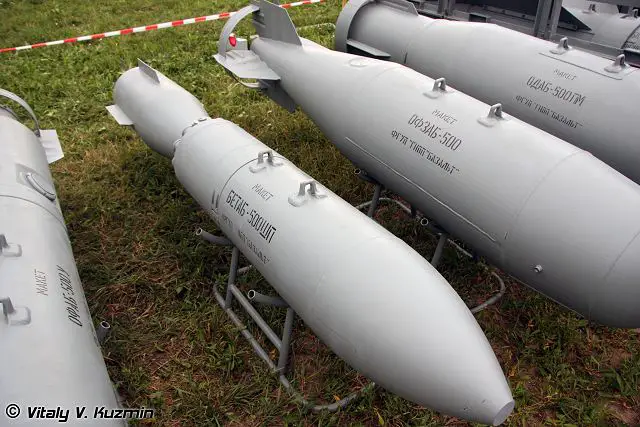 BetAB 500 Concrete Piercing bomb BetAB 500 Concrete Piercing bomb |
|||


























